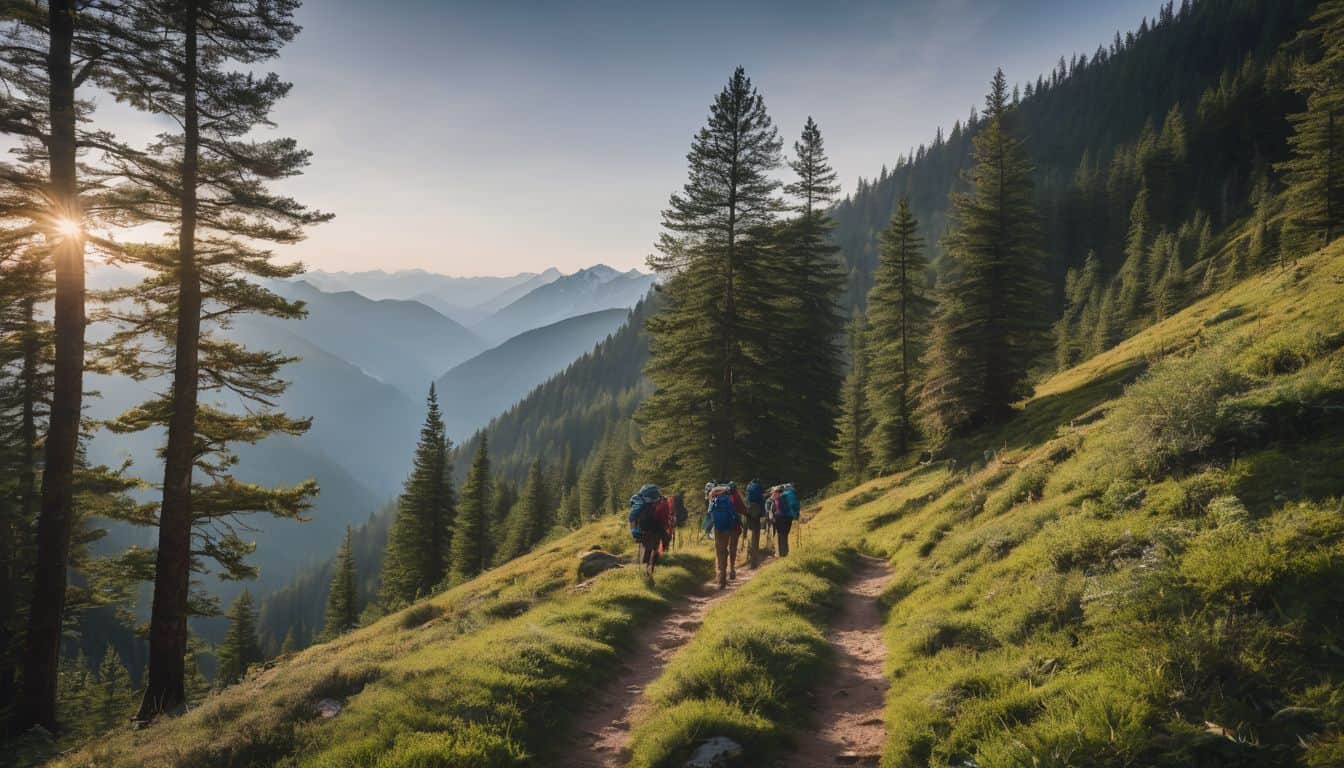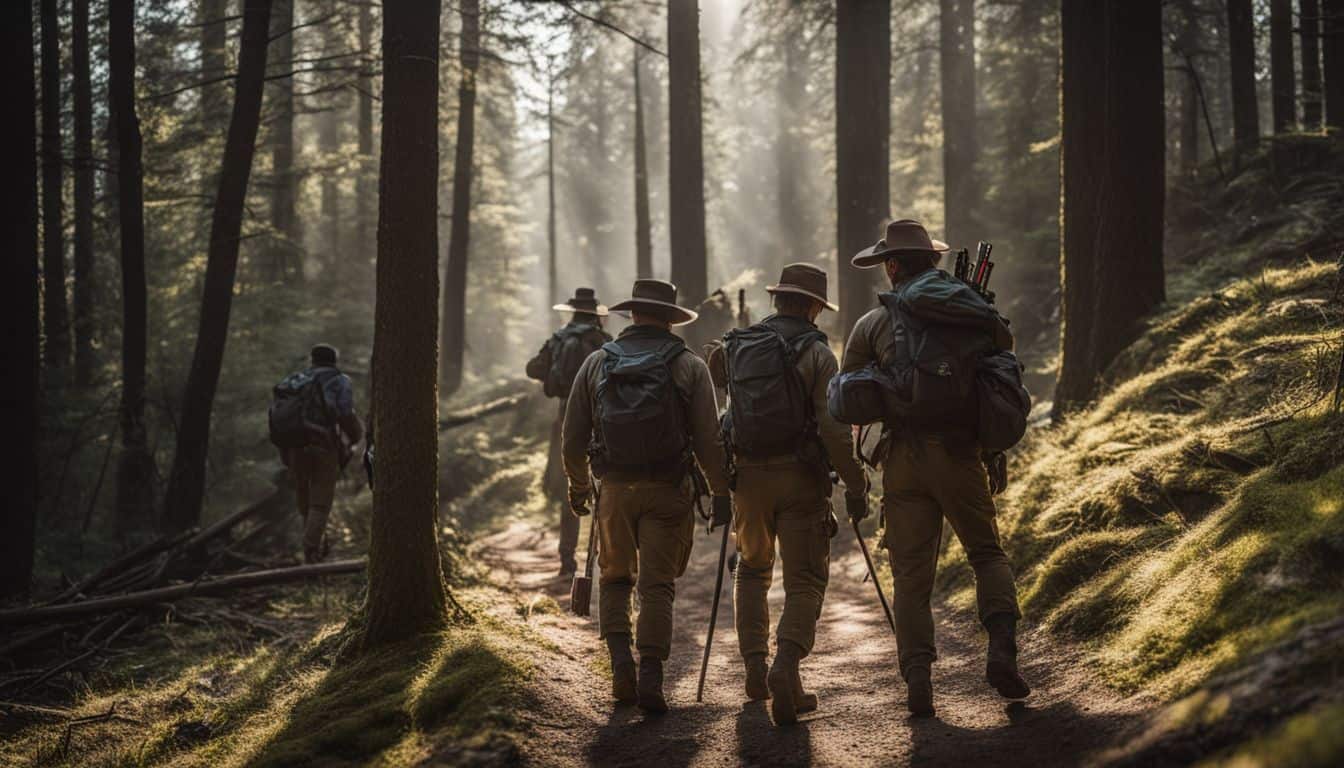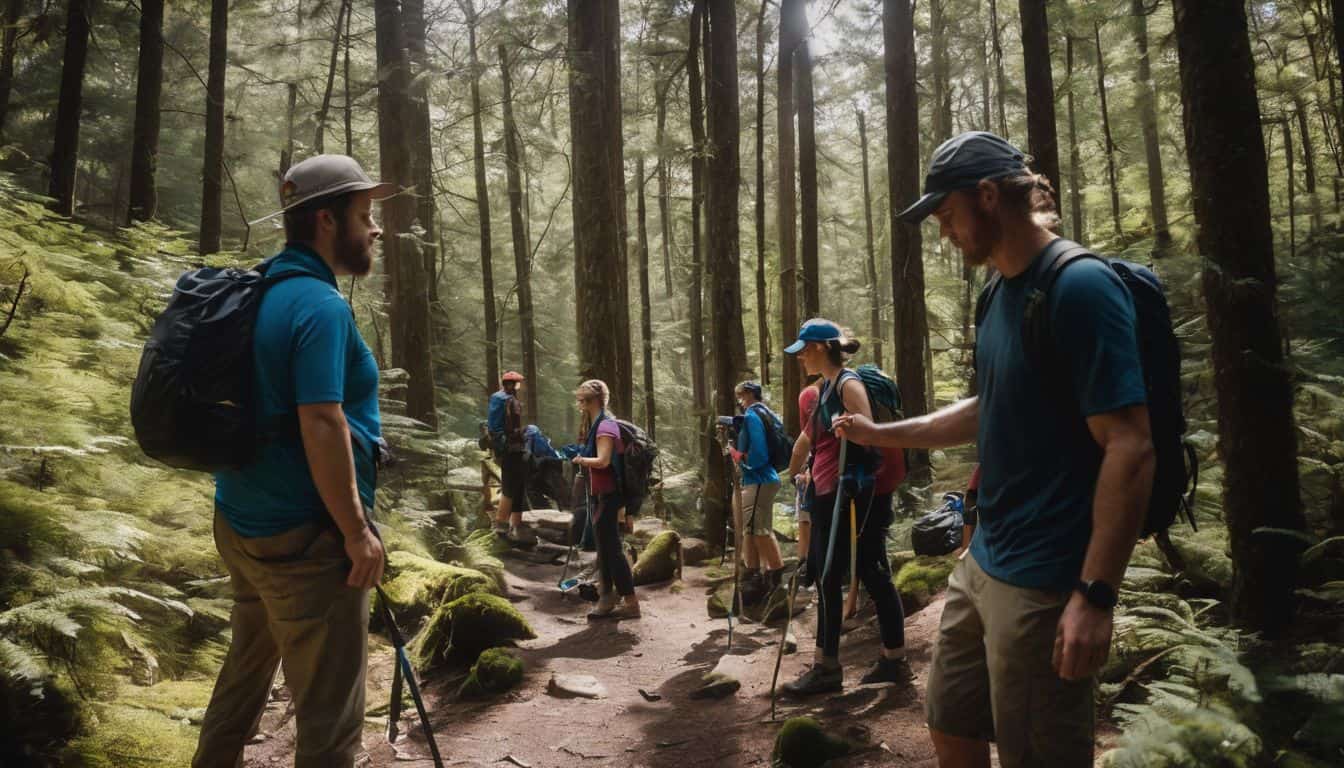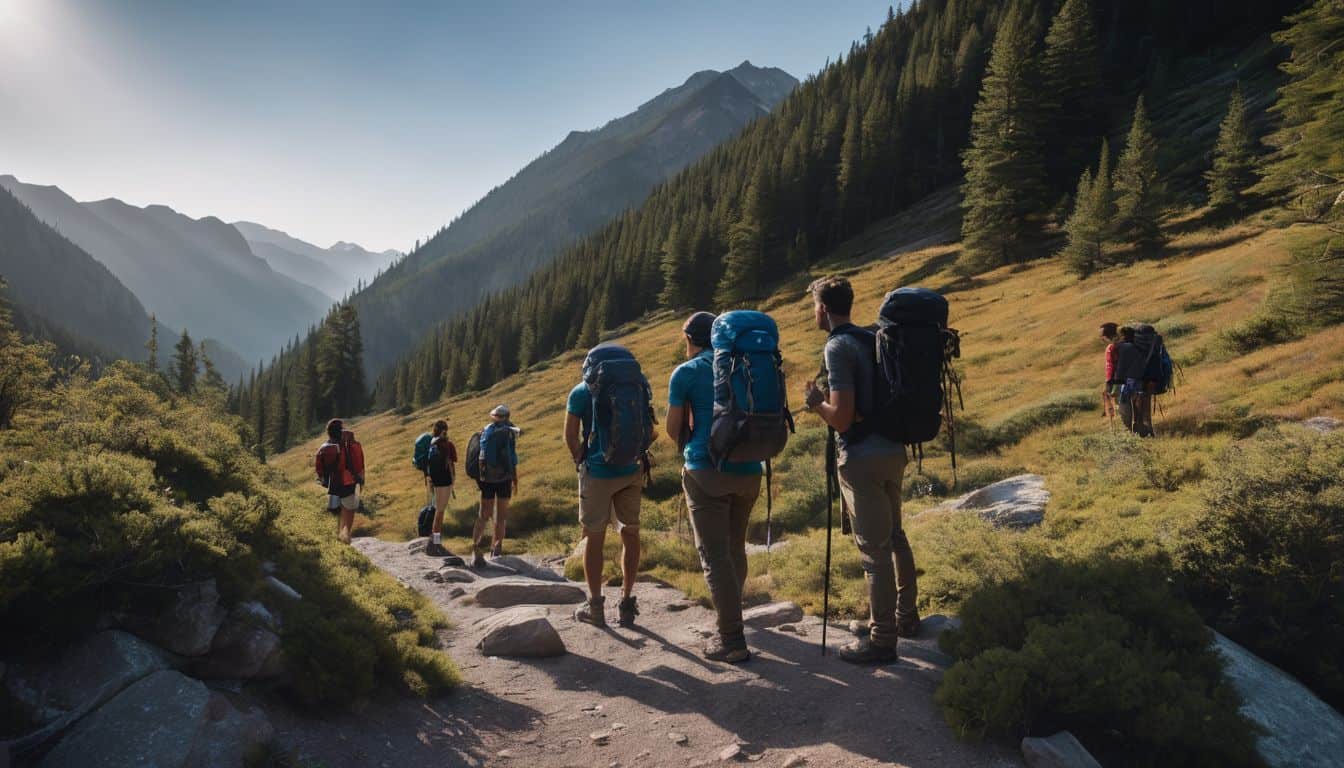Does the thought of a scenic hiking trail quicken your pulse and stir up excitement, even as you notice those beloved paths gradually succumbing to wear and tear over time? I can tell you that I’ve packed many miles under my boots feeling just the same – a passionate hiker at heart who also deeply cherishes these magnificent gifts from Mother Nature.
There’s plenty of research supporting our intuition: thorough trail maintenance dramatically boosts their longevity while also safeguarding precious wildlife habitats. In this blog post, we’ll venture together into the significance of caring for our trails and share nine incredible tips to make any dedicated stewardship project successful.
So, are you ready to tread down this path with us? Let’s get started!
Key Takeaways
- Trail maintenance is crucial for ensuring the safety of trail users, preserving the overall trail experience, protecting wildlife and habitats, and preventing erosion and damage to the environment.
- Regular inspections and repairs are important for maintaining safe and enjoyable trails. This includes checking signage, addressing erosion or damage promptly, trimming trees, and conducting regular safety inspections.
- Trail tread maintenance involves repairing the trail surface and ensuring it meets design standards. This includes filling in potholes, fixing cracks and erosion, clearing debris, reinforcing weak spots, maintaining proper drainage, using durable materials, staying updated on construction standards, and monitoring effectiveness.
- Weight management is essential for hikers to minimize their impact on trails. Lightening your load by reducing gear weight improves strength and fitness while reducing wear and tear on trails. Reducing impact also involves following sustainable trail design practices to create durable paths that are less prone to erosion.
The Importance of Trail Maintenance
Trail maintenance is crucial for ensuring the safety of trail users, preserving the overall trail experience, protecting wildlife and habitats, and preventing erosion and damage to the environment.
Ensuring trail user safety
Trail upkeep is key for your safety. It’s not just about a clean path. Safety signs are the most vital part of this effort. They warn you and help avoid danger on the trail. I have seen many volunteers work hard to maintain these signs and trails.
By doing so, they make sure our hike is safe and fun! Let’s all do our part too!
Preserving the trail experience
We all love using trails for fun. We hike, run, bike, and even take our pets on the trails. The joy we feel on the trail is special. To keep this joy alive, we need to care for our trails.
Trail upkeep helps to save the trail experience. It fixes any damage on the path and makes it last longer. By doing this, we can use these paths many times without them getting bad or unsafe.
It’s also key to keep water flowing off the trail in a natural way. If not done right, water can cause harm to paths over time by causing erosion.
There are more things that matter when it comes to fixing up trails too! Trails have a story of their own from long ago past times and they house animals as well. In working on them, one needs to think about how not to hurt these things.
A team like Pacific Crest Trail Association (PCTA) works every year make sure paths stay safe and clean so people can enjoy them more each time they visit.
Protecting wildlife and habitats
Taking care of trails is important for saving animals and their homes. We build trails in a way that doesn’t hurt these areas or break up lands or waters that are vital to them. This helps to keep the beauty and life we love about nature safe.
The right trail work also connects broken habitats back together again. It can tie natural landscapes together that have been cut apart by roads, cities, or farms. This makes it easier for wildlife to move about safely and find food or mates even in our changing world.
Preventing erosion and damage
Proper trail maintenance is crucial in preventing erosion and damage. Erosion not only affects the safety of hikers but also impacts their overall experience on the trail. Additionally, it can lead to sedimentation in nearby streams, causing pollution and harming wildlife habitats.
By following best management practices for erosion control during trail construction and maintenance, we can help preserve the natural resources like wetlands and ensure slope stability.
It’s important to implement effective measures such as grass erosion control to prevent surface erosion from slopes. With a proactive approach to trail maintenance, we can protect the trails for everyone’s enjoyment while conserving our beautiful outdoor spaces.
A Comprehensive Guide on the Importance of Trail Maintenance

Proper trail maintenance is crucial for preserving the trails we love to hike on. It helps ensure that the trails are safe and enjoyable for everyone. Trail maintenance involves tasks like repairing the trail surface, maintaining its design standards, and restoring natural drainage patterns.
By doing these things, we can prevent erosion and protect the surrounding wildlife and habitats.
Regular inspections are also an important part of trail maintenance. They help us identify any issues or potential hazards on the trail so that they can be addressed promptly. Additionally, when planning trail management and maintenance, it’s essential to consider factors like historical significance and potential impact of other trails.
It’s worth noting that proper trail maintenance does come with a cost. On average, it can range from $5,000 to $7,000 per mile per year. That’s why responsible budgeting by agencies is necessary to ensure adequate funding for maintaining our trails in good condition.
As hikers who enjoy exploring nature on foot, it is our responsibility to give back to the trails we love by supporting organizations dedicated to their preservation and participating in volunteer opportunities whenever possible.
Regular Trail Inspection
Regular trail inspection is an important aspect of trail maintenance. It helps ensure the safety of hikers and preserve the overall trail experience. Here are some key things to consider during regular trail inspections:
- Check the condition of railings, bridges, and trail surfaces to make sure they are safe and in good shape.
- Ensure that proper signage is in place to guide hikers and prevent them from getting lost.
- Look for any signs of erosion or damage on the trail and address these issues promptly.
- Trim trees that might obstruct the trail or pose a safety hazard.
- Conduct regular safety inspections to identify any potential risks or hazards.
- Report any issues or problems you find during your inspection to the appropriate trail staff.
Trail Tread Maintenance
Trail tread maintenance is essential for preserving the integrity and longevity of hiking trails. It involves repairing the trail surface and ensuring that it meets design and construction standards.
Repairing trail surface
Repairing the trail surface is an important part of trail maintenance. Here are some key tips for success:
- Identify damaged areas: Regularly inspect the trail to spot any sections that need repair or maintenance.
- Fill in potholes: Potholes can make hiking difficult and unsafe. Fill them in with appropriate materials to ensure a smooth and even trail surface.
- Fix cracks and erosion: Cracks and erosion can lead to further damage if left unattended. Repair them promptly using appropriate techniques and materials.
- Clear debris: Remove any fallen branches, rocks, or other debris from the trail surface to prevent hazards and maintain a clear path.
- Reinforce weak spots: Pay attention to areas that are prone to wear and tear, such as steep slopes or high traffic areas, and reinforce them with additional support if necessary.
- Maintain proper drainage: Ensure that water drains properly from the trail surface to prevent standing water or erosion issues.
- Use durable materials: Choose materials that are suitable for the specific terrain and weather conditions to ensure long-lasting repairs.
- Stay updated on construction standards: Keep yourself informed about the latest guidelines for trail construction and follow them when repairing the trail surface.
- Monitor effectiveness: Regularly assess the effectiveness of your repairs to identify any recurring issues or areas that may need extra attention.
Maintaining trail design and construction standards
Maintaining trail design and construction standards is crucial for ensuring safe and enjoyable hiking experiences. Here are some important tips to help you keep the trails in great shape:
- Regular inspection: Regularly inspect the trails to identify any potential hazards or areas that need repair.
- Repairing trail surface: Fix any uneven surfaces or damage on the trail to prevent accidents and provide a smooth hiking experience.
- Obstacle removal: Clear the trail of any protruding roots, rocks, or fallen debris that could trip hikers.
- Drainage upkeep: Ensure proper drainage on the trails to prevent erosion and water accumulation, which can lead to trail damage.
- Preserve natural environment: Design and construct trails in a way that minimizes impact on surrounding wildlife habitats and ecosystems.
- Accessible trail design: Consider accessibility for all hikers by incorporating features like ramps, handrails, or wider paths where needed.
- Sustainable development: Adopt sustainable practices in trail construction, such as using locally sourced materials and minimizing disturbance to natural resources.

Importance of Weight Management
In trail maintenance, weight management is crucial for hikers and the sustainability of trails. Reducing the load carried by hikers helps minimize their impact on trails, ensuring they remain in good condition for others to enjoy.
Lightening the load for hikers
When you go hiking or backpacking, it’s important to lighten your load. Carrying a heavy backpack can be tiring and put strain on your body. By reducing the weight you have to carry, you can improve your strength, fitness, and overall well-being.
Plus, hiking with a lighter load means you can move faster and cover more distance during your trips. To achieve this, focus on minimizing the weight of your gear and clothes. Pay attention to your “base weight,” which includes everything in your pack except for consumables like food, water, and fuel.
The lighter you go, the more comfortable and safe your hiking experience will be.
Reducing impact on trails
Reducing our impact on trails is crucial for maintaining their integrity and ensuring their sustainability. One important aspect of reducing impact is weight management, particularly for hikers.
By lightening our load and carrying only what is necessary, we can minimize the wear and tear on the trails. This helps to prevent erosion and damage, preserving the natural beauty of the trail for future generations to enjoy.
Additionally, following sustainable trail design practices can further reduce our impact by creating durable and resilient paths that are less prone to erosion. By being mindful of our actions while on the trails, we can help protect these valuable resources and ensure that they remain accessible for years to come.
Adaptability in Trail Maintenance
Being prepared for unexpected challenges and having flexibility in your maintenance plans is crucial for success in trail maintenance.
Being prepared for unexpected challenges
I know that trail maintenance can come with unexpected challenges. As a hiker, it’s important to be prepared for anything that may come your way. Here are some tips to help you face these challenges head-on:
- Stay informed: Keep up-to-date with weather forecasts and trail conditions before heading out on your hike.
- Pack the essentials: Always have a well-stocked backpack with items such as extra clothing, first aid supplies, a map, compass, and plenty of water and snacks.
- Be flexible: Sometimes the unexpected happens, like fallen trees or washed-out sections of the trail. Have a backup plan or alternative routes in mind.
- Practice safety measures: Carry a whistle or signal device to alert others if you need help. It’s also essential to follow safety guidelines and stay on marked trails.
- Communicate with others: Let someone know your hiking plans and expected return time. This way, if something goes wrong, they can alert authorities if necessary.
- Utilize trail organizations: Connect with local trail organizations who can provide valuable information and support during challenging situations.
- Seek guidance from experienced hikers: Learn from those who have faced similar challenges before you. Their knowledge and advice can be invaluable in difficult situations.
- Take care of yourself: Stay physically fit and mentally prepared for the demands of hiking on rugged trails. Regular exercise can help build strength and endurance.
- Stay positive: Remember that facing unexpected challenges is part of the adventure! Embrace the opportunity to problem solve and learn new skills along the way.
Flexibility in maintenance plans
Flexibility in trail maintenance plans is important for the long-term success of trails. Here are some tips to help maintain a flexible approach:
- Being prepared for unexpected challenges: Trails can face unforeseen issues like fallen trees or severe weather events. By having a plan in place to quickly address these challenges, trail maintainers can ensure that trails remain safe and accessible.
- Flexibility in maintenance schedules: It’s important to be adaptable when it comes to scheduling maintenance activities. This means being open to adjusting dates and times based on factors like weather conditions or other priorities.
- Collaborating with reliable partners: Working with dedicated individuals and organizations can help distribute the workload and ensure that maintenance tasks are completed on time. This collaborative approach increases the likelihood of successfully adapting to changing circumstances.
- Seeking input from trail users: Regularly connecting with hikers, bikers, and other trail users allows maintainers to gather feedback on potential issues or needed improvements. This valuable input can inform decisions about adjusting maintenance plans as necessary.
- Regular monitoring and evaluation: Conducting regular inspections and evaluations of the trail condition helps identify areas that may require immediate attention or adjustments to the maintenance plan. This proactive approach ensures that potential problems are addressed before they escalate.
Choosing the Right Trail Partners
Collaborate with reliable and dedicated individuals, building a strong support system to ensure successful trail maintenance.
Collaborating with reliable and dedicated individuals
Choosing the right trail partners is crucial for successful trail maintenance. It is important to collaborate with reliable and dedicated individuals who share a common goal of preserving and protecting the trails.
By working together, we can build a strong support system that motivates and supports each other in our stewardship efforts. Trustworthy and committed partners will help ensure that the trail maintenance tasks are carried out effectively and efficiently.
Together, we can make a positive impact on the trails and create an enjoyable hiking experience for everyone.
Building a strong support system
To ensure successful trail maintenance, building a strong support system is essential. By collaborating with reliable and dedicated individuals, we can share the responsibility of maintaining trails.
Working together, we can contribute our skills and resources to keep the trails in good condition for everyone to enjoy. This support system can include fellow hikers, local community members, and trail organizations that are passionate about preserving and protecting these natural spaces.
With a strong team behind us, we can tackle challenges more effectively and make a meaningful impact on trail maintenance efforts.
Overcoming Challenges and Not Giving Up
Overcoming challenges while hiking requires resilience, determination, and adaptability. It’s important to remember that stepping into discomfort is a part of the journey. Building mental toughness involves positive thinking and daily practice.
When faced with obstacles, it’s crucial to turn them into stepping stones towards success. Whether it’s putting off goals or facing difficulties, we must push through and persevere.
Remember that overcoming challenges takes courage, persistence, and willpower.
As hikers, we encounter various obstacles on the trail that test our endurance and motivation. Sometimes unexpected challenges arise that require us to be adaptable in our plans. It’s important to be prepared for these situations and have a flexible mindset when maintaining trails.
By seeking mentorship from experienced trail maintainers and learning from their expertise, we can acquire valuable knowledge on how to overcome challenges successfully.
Volunteers play a vital role in trail maintenance efforts by giving back to the trails and trail communities they love. Through volunteer opportunities and supporting trail organizations, we can contribute not only physically but also financially to ensure the preservation of trails for future generations of hikers.
So let’s stay determined in overcoming challenges along the way, knowing that our efforts are making a difference in creating enjoyable hiking experiences for all.
Seeking Mentorship and Learning from Experienced Trail Maintainers
I believe that seeking mentorship and learning from experienced trail maintainers is crucial for success in trail maintenance. These seasoned experts can provide valuable guidance, advice, and support to help us navigate the challenges of maintaining trails effectively.
With their knowledge, expertise, and training, we can learn best practices, gain insights into different techniques, and discover innovative solutions to common problems. By actively seeking out mentors in the field of trail maintenance, we can accelerate our learning process and increase our chances of success.
So let’s take advantage of this opportunity to learn from those who have already walked the path before us!
Giving Back to the Trails and Trail Communities
Volunteer opportunities provide a chance to contribute to the maintenance and preservation of trails, while supporting trail organizations helps ensure the sustainability and growth of trail communities.
Volunteer opportunities
Volunteering for trail maintenance is a great way to give back to the trails and trail communities. It allows you to make a positive impact and contribute to outdoor stewardship efforts. Here are some amazing volunteer opportunities you can consider:
- Join a trail maintenance program: Organizations like the Washington Trails Association rely on dedicated volunteers for their trail maintenance programs. By joining them, you can help maintain and improve hiking trails in your area.
- Participate in multi-day volunteer projects: Trail crews often offer multi-day volunteer opportunities where you can camp out in nature while working on trail maintenance. It’s a meaningful experience that allows you to fully immerse yourself in outdoor conservation efforts.
- Coordinate with local groups: The American Hiking Society can help coordinate and promote volunteer trail maintenance groups. You can connect with these groups to get involved and contribute your time and skills.
- Overcome challenges and enjoy nature: Volunteering for trail maintenance may come with challenges, but it’s also highly rewarding. You get the chance to overcome obstacles while enjoying the beauty of nature.
- Create community connections: Many park managers seek help from local communities, which leads to the growth of a new generation of trail maintenance volunteers. By getting involved, you can connect with like-minded individuals who share your passion for the outdoors.
Supporting trail organizations
Trail organizations are crucial in supporting and giving back to the trails and trail communities. Here are some ways you can support these organizations:
- Get involved: Join volunteer organizations that focus on trail maintenance. By volunteering your time and skills, you can contribute to the upkeep of trails and help create a better outdoor experience for everyone.
- Donate: Trail organizations rely on donations to fund their programs and initiatives. Consider making a financial contribution to support their work in maintaining and preserving trails.
- Spread awareness: Share information about trail organizations and their efforts with your friends, family, and fellow hikers. By raising awareness, you can help generate more support for these important causes.
- Participate in fundraisers: Many trail organizations organize fundraisers to raise funds for trail maintenance projects. Take part in these events or encourage others to participate as well.
- Attend workshops and events: Trail organizations often hold educational workshops and events related to trail stewardship and conservation efforts. Attend these sessions to expand your knowledge and learn best practices for trail maintenance.
- Advocate for public lands: Support policies that protect public lands, which include the trails we love to explore. Stay informed about legislative issues affecting public lands and speak up for their preservation.
- Follow sustainable practices: When enjoying the outdoors, practice Leave No Trace principles by minimizing your impact on the environment. This includes staying on designated trails, properly disposing of waste, and respecting wildlife habitats.
Conclusion on Importance Of Trail Maintenance
In conclusion, trail maintenance is essential for the safety and enjoyment of hikers. By regularly inspecting and repairing trails, we can preserve their natural beauty and protect wildlife habitats.
It’s important to choose the right partners, be adaptable in our maintenance plans, and learn from experienced trail maintainers. By giving back to the trails and supporting trail organizations, we can ensure that these amazing outdoor spaces remain accessible for future generations.
So let’s take care of our trails and keep them in tip-top shape!
FAQs on Importance Of Trail Maintenance
1. Why is trail maintenance important?
Trail maintenance is important to ensure the safety and accessibility of trails for hikers, bikers, and other outdoor enthusiasts. It helps prevent erosion, keeps paths clear of debris, and maintains a pleasant experience in nature.
2. How often should trail maintenance be done?
Trail maintenance should be done regularly, preferably at least once or twice a year depending on usage and weather conditions.
3. What are some tips for successful trail maintenance?
Some tips for successful trail maintenance include clearing fallen branches and debris, repairing erosion damage, marking trails clearly with signs or blazes, trimming overgrown vegetation along the path, and engaging volunteers or professional crews for larger projects.
4. Can I do trail maintenance by myself?
While small tasks like picking up litter can be done individually, larger-scale trail maintenance is best carried out with a team of trained volunteers or professionals who have the necessary tools and expertise.
5. Who is responsible for trail maintenance?
Responsibility for trail maintenance varies depending on the location and ownership of the trails. It can be managed by government agencies such as parks departments or non-profit organizations dedicated to outdoor recreation.





Leave a Reply